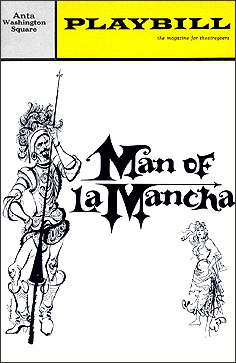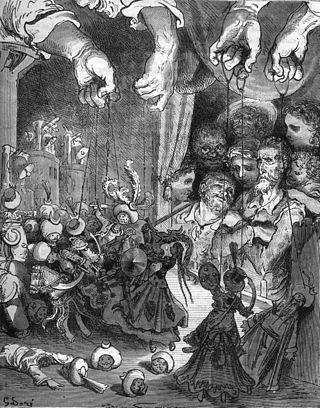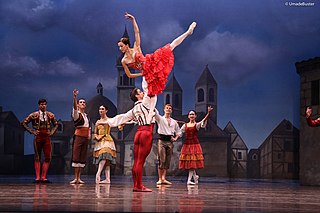
Don Quixote, the full title being The Ingenious Gentleman Don Quixote of La Mancha, is a Spanish novel by Miguel de Cervantes. It was originally published in two parts, in 1605 and 1615. Considered a founding work of Western literature, it is often labelled as the first modern novel. Don Quixote is also one of the most-translated books in the world and one of the best-selling novels of all time.

Miguel de Cervantes Saavedra was an Early Modern Spanish writer widely regarded as the greatest writer in the Spanish language and one of the world's pre-eminent novelists. He is best known for his novel Don Quixote, a work considered as the first modern novel. The novel has been labelled by many well-known authors as the "best book of all time" and the "best and most central work in world literature".

Man of La Mancha is a 1965 musical with a book by Dale Wasserman, music by Mitch Leigh, and lyrics by Joe Darion. It is adapted from Wasserman's non-musical 1959 teleplay I, Don Quixote, which was in turn inspired by Miguel de Cervantes and his 17th-century novel Don Quixote. It tells the story of the "mad" knight Don Quixote as a play within a play, performed by Cervantes and his fellow prisoners as he awaits a hearing with the Spanish Inquisition. The work is not and does not pretend to be a faithful rendition of either Cervantes' life or Don Quixote. Wasserman complained repeatedly about people taking the work as a musical version of Don Quixote.

La Mancha is a natural and historical region in the Spanish provinces of Albacete, Cuenca, Ciudad Real, and Toledo. It is a fertile plateau that stretches from the mountains of Toledo to the western spurs of the Cuenca hills, bordered to the south by the Sierra Morena and to the north by the Alcarria. The La Mancha historical comarca constitutes the southern portion of Castilla-La Mancha autonomous community and makes up most of the present-day administrative region.

Dulcinea del Toboso is a fictional character who is unseen in Miguel de Cervantes' novel Don Quixote. Don Quixote believes he must have a lady, under the mistaken view that chivalry requires it. As he does not have one, he invents her, making her the very model of female perfection: "[h]er name is Dulcinea, her country El Toboso, a village of La Mancha, her rank must be at least that of a princess, since she is my queen and lady, and her beauty superhuman, since all the impossible and fanciful attributes of beauty which the poets apply to their ladies are verified in her; for her hairs are gold, her forehead Elysian fields, her eyebrows rainbows, her eyes suns, her cheeks roses, her lips coral, her teeth pearls, her neck alabaster, her bosom marble, her hands ivory, her fairness snow, and what modesty conceals from sight such, I think and imagine, as rational reflection can only extol, not compare".

Sancho Panza is a fictional character in the novel Don Quixote written by Spanish author Miguel de Cervantes Saavedra in 1605. Sancho acts as squire to Don Quixote and provides comments throughout the novel, known as sanchismos, that are a combination of broad humour, ironic Spanish proverbs, and earthy wit. "Panza" in Spanish means "belly".

A knight-errant is a figure of medieval chivalric romance literature. The adjective errant indicates how the knight-errant would wander the land in search of adventures to prove his chivalric virtues, either in knightly duels or in some other pursuit of courtly love.

Rocinante (Rozinante) is Don Quixote's horse in the 1605/1615 novel Don Quixote by Miguel de Cervantes. In many ways, Rozinante is not only Don Quixote's horse, but also his double; like Don Quixote, he is awkward, past his prime, and engaged in a task beyond his capacities.

Monsignor Quixote is a novel by Graham Greene, published in 1982. The book is a pastiche of the early 1600s novel Don Quixote by Miguel de Cervantes with many moments of comedy, but also offers reflection on matters such as life after a dictatorship, Communism, and the Catholic faith.

Alonso Fernández de Avellaneda is the pseudonym of a man who wrote a sequel to Cervantes' Don Quixote, before Cervantes finished and published his own second volume.

El retablo de maese Pedro is a puppet-opera in one act with a prologue and epilogue, composed by Manuel de Falla to a Spanish libretto based on an episode from Don Quixote by Miguel de Cervantes. The libretto is an abbreviation of chapter 26 of the second part of Don Quixote, with some lines added from other parts of the work. Falla composed this opera "in devoted homage to the glory of Miguel de Cervantes" and dedicated it to the Princess de Polignac, who commissioned the work. Because of its brief length by operatic standards, its very challenging part for a boy opera performer, and its use of puppets, it is not part of the standard operatic repertoire.

Don Quixote is a ballet in three acts, based on episodes taken from the famous novel Don Quixote de la Mancha by Miguel de Cervantes. It was originally choreographed by Marius Petipa to the music of Ludwig Minkus and first presented by Moscow's Bolshoi Ballet on 26 December [O.S. 14 December] 1869. Petipa and Minkus revised the ballet into a more elaborate and expansive version in five acts and eleven scenes for the Mariinsky Ballet, first presented on 21 November [O.S. 9 November] 1871 at the Imperial Bolshoi Kamenny Theatre of St. Petersburg.

Quixotism is impracticality in pursuit of ideals, especially those ideals manifested by rash, lofty and romantic ideas or extravagantly chivalrous action. It also serves to describe an idealism without regard to practicality. An impulsive person or act might be regarded as quixotic.
Tilting at windmills is an English idiom which means "attacking imaginary enemies", originating from Miguel de Cervantes' novel Don Quixote.
Don Quixote (1933) is a British-French film adaptation of the classic Miguel de Cervantes novel, directed by Georg Wilhelm Pabst, starring the famous operatic bass Feodor Chaliapin. Although the film stars Chaliapin, it is not an opera. However, he does sing four songs in it. It is the first sound film version of the Spanish classic. The supporting cast in the English version includes George Robey, René Donnio, Miles Mander, Lydia Sherwood, Renée Valliers, and Emily Fitzroy. The film was made in three versions—French, English, and German—with Chaliapin starring in all three versions.

Don Quixote is a 1955 sketch by Pablo Picasso of the Spanish literary hero and his sidekick, Sancho Panza. It was featured on the August 18–24 issue of the French weekly journal Les Lettres Françaises in celebration of the 350th anniversary of the first part, published in 1605, of the Miguel de Cervantes novel Don Quixote. Made on August 10, 1955, the drawing Don Quixote was in a very different style than Picasso’s earlier Blue, Rose, and Cubist periods.

Donkey Xote is a 2007 animated children's film produced by Lumiq Studios. A co-production between Spain and Italy, the film is directed by José Pozo and written by Angel Pariente, based on the Miguel de Cervantes novel Don Quixote, and features the voices of Andreu Buenafuente, David Fernández, Sonia Ferrer and José Luis Gil. The film has gained notoriety as a mockbuster as the lead character Rucio bears an intentional resemblance to Donkey from the Shrek film series, along with the poster and trailer having the tagline "From the producers who saw Shrek".

Quichotte is a 2019 novel by Salman Rushdie. It is his fourteenth novel, published on 29 August 2019 by Jonathan Cape in the United Kingdom and Penguin Books India in India. It was published in the United States on 3 September 2019 by Random House. Inspired by Miguel de Cervantes's classic novel Don Quixote, Quichotte is a metafiction that tells the story of an addled Indian-American man who travels across America in pursuit of a celebrity television host with whom he has become obsessed.















